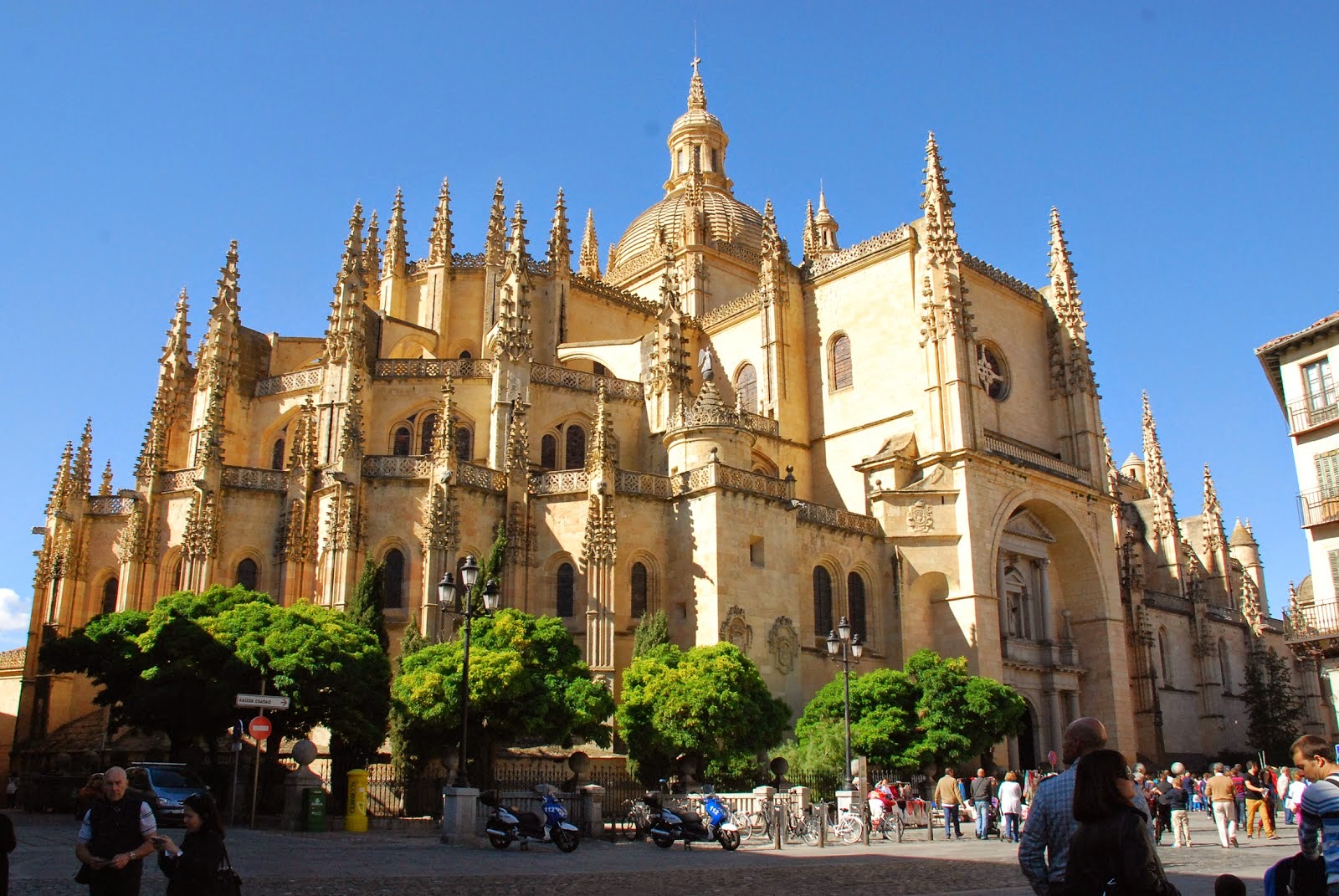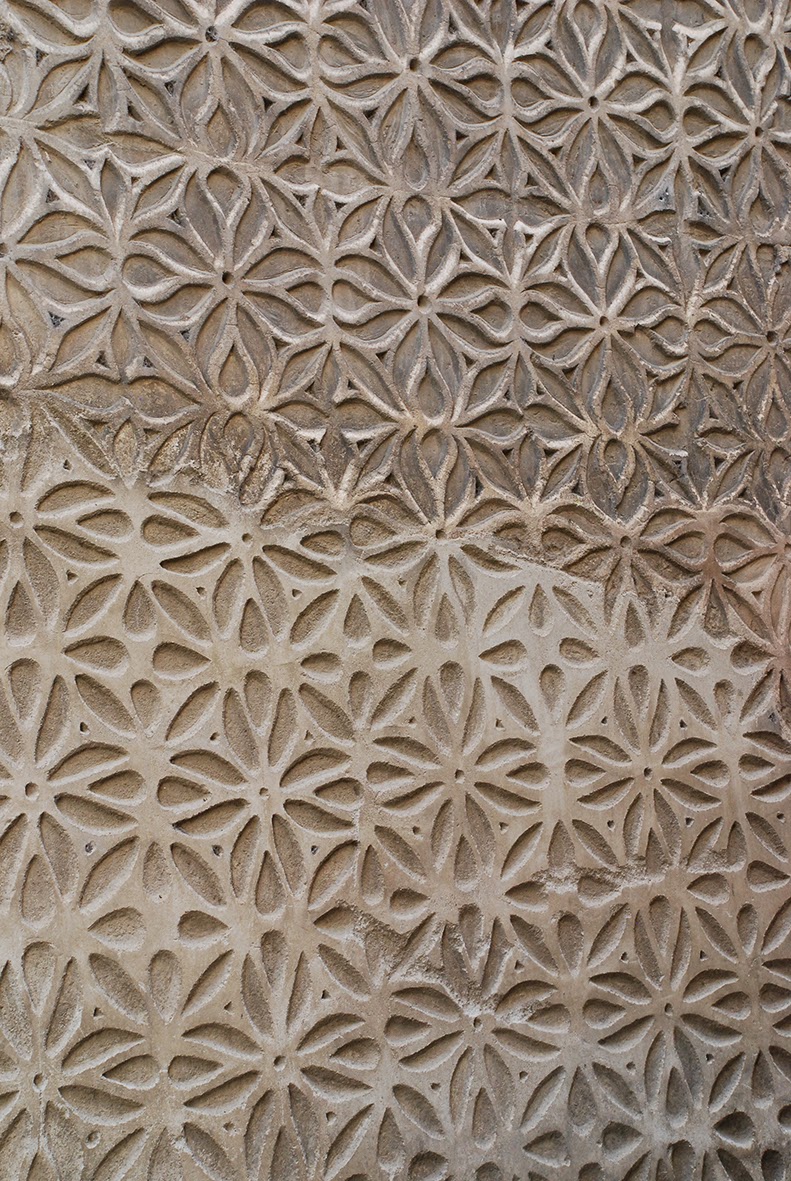Once called Segobriga (in Celtiberian 'sego' meant 'victory' and 'briga' meant 'city', thus 'Victorious city'), the city can trace its history back to Celtic times. It was later captured by the Romans, who gave the city its current name of Segovia. However, the name is not all we have to thank the Romans for; they were responsible for building one of the city's greatest sights and the reason I wanted to visit – the aqueduct.
Built around 50 AD, the Roman aqueduct is incredibly well-preserved. It is 813 metres long (approx. 1,043.5 ft), almost 30 metres high (98.5 ft), and is supported by 166 arches and 120 pillars (I didn't count them – I just lifted the facts from the Rough Guide). Together with the old city, the aqueduct is now a UNESCO World Heritage Site, and rightfully so.
 |
| The aqueduct in the sun |
I had every good intention of getting the 09:40 train to Segovia. That is, until my alarm went off at 08:00. Usually I'm quite good about getting up, but too many late nights had taken their toll on me. So I reset my alarm for an hour later and went back to sleep. Mistake #1.
I managed to leave the house a little before 10:00, safe in the knowledge that the metro to Chamartín would only take ten minutes – perfect timing for the 10:30 train. Or so I thought. I hadn't banked on there being absolutely NO useful signage at Chamartín station. Looking for said signage cost me five of my precious twenty minutes, but I did eventually locate the ticket office... where I discovered that the queues for on-the-day train tickets were insanely long. All five of them. Oops. Mistake #2.
I picked what looked like the shortest queue. Ha! Mistake #3. Naturally the old couple at the counter took forever and a day to count out their money to the last cent. That was probably the final nail in the coffin of my chances of catching the 10:30 train, but when my turn finally came, I bounded forward full of hope. Unfortunately, despite my best efforts in Spanish, I had landed the surliest cashier ever. He got really grumpy when I misunderstood his question about return times, and as he handed me my ticket, he spitefully told me I was on the 11:30 train, then rudely dismissed me with a wave of his hand and called, "Siguiente" (next). So while I had a ticket, I also had an hour-and-a-bit's wait. Sigh.
But despite all the drama and the mistakes, I made it to Segovia train station. One fifteen-minute bus ride later (a bargainous 95c/77p/US$1.30) and all was forgiven. I was just outside the town centre and at the foot of the very thing I'd come to see – the Roman aqueduct. And it was absolutely stunning! I could have stood there photographing it all day...
 |
| Literally my very first view of Segovia |
 |
| Climbing the steps to the viewpoint |
 |
| To infinity and beyond (not really) |
 |
| View of Plaza de la Artillería from the aqueduct |
 |
| Casting shadows |
With a few (hundred) photos taken, there was more exploring to do. Being a public holiday, Segovia was incredibly busy, but by avoiding the main drags I managed to escape the worst of the crowds.
 |
| Typical Segovian street |
Somehow, despite having taken a quieter route, I ended up in Plaza Mayor with its wedding cake of a cathedral. It reminded me a little of Mosteiro da Batalha (Battle Abbey) in Portugal. I was excited to see inside, although once there I was fairly underwhelmed. The 17th century gold altarpiece in the chapel of St Antón was definitely picture-worthy though!
 |
| The cathedral – good enough to eat! |
 |
| A slice of cathedral! |
 |
| Close-up of a two-headed bird |
 |
| The altarpiece in the chapel of St Antón |
Outside the cathedral there was only one thing to do – follow the crowds who were obviously heading to the Alcázar. Described by Rough Guide as "an extraordinary fantasy of a castle" I had to go see what all the fuss was about. The original dated from the fourteenth and fifteenth centuries but was rebuilt (and redesigned) after a fire almost completely destroyed it in 1862. The current creation is believed to have served as the model for the original Disneyland castle in California. Perhaps that's why it's so popular?
By the time I got there the queue for the ticket office was out the door and all the way into the park in the front of the castle. I was so NOT prepared to join it. And so I turned around and walked against the relentless flow of pedestrian traffic back into the centre of the town. And in doing so discovered something far better – endless examples of esgrafiado, a style of plasterwork that dates back to Moorish rule and is typical of Segovia. Designs can be floral or geometric and, whether simple or intricate, they add an elegance to what would otherwise be a plain façade. It was love at first sight!
 |
| Decorative wall en-route to the Alcázar |
 |
| Old esgrafiado |
 |
| Modern esgrafiado, with minerals mixed through to add colour |
 |
| Traditional plasterwork (top) with a modern touch-up |
I walked around, camera in hand, marvelling at the variation in plasterwork. I ended up in the Jewish quarter, where I came across a conveniently-located café, the perfect spot for a cup of tea and a slice of cake! Refreshed, I did some more wandering.
My travels took me into Plaza de San Martín, allegedly one of the city's grandest squares, where I found the attractive twelfth-century Romanesque Iglesia de San Martín (St Martin's Church).
 |
| St Martín's Church |
In the centre of the square was a statue, which I stopped to photograph. It turned out to be local folk hero, Juan Bravo (1483-1521), the leader of the short-lived rebel Comuneros during the Guerra de las Comunidades de Castilla (War of the Castilian Communities).
 |
| Statue of Juan Bravo (1483-1521) |
Some time later, I came across Casa de los Picos (the House of Spikes), a 15th century building with a rather odd-looking façade made up of pyramid-shaped stones which catch the light and cast interesting shadows. I had never seen anything like it! The narrow street made it difficult to take the photo I'd have liked to, but I eventually managed to capture something representative of what I was seeing.
 |
| The intriguing Casa de los Picos |
 |
| Taking a closer look at the stones |
Around the corner, I stopped to photograph a sleeping dog. Not far from the dog was a stand selling roasted chestnuts, and drawn in by the smell wafting over, I bought some. I had tried them before in Portugal and really wasn't that keen, but I love the smell and the idea of eating them so I thought I'd try again. I actually kind of liked them. Perhaps they roast them differently here.
 |
| Dozing dog |
By now an hour and a half had passed so I thought I'd try the Alcázar again. This time I was in luck. The queue was about three people long. I paid for a ticket to both the palace and the tower (€6.50/£5.30/US$8.90). The palace was fairly average, although some of the ceilings were amazing. The panoramic views were worth every cent though.
 |
| Disneyland or plain old Alcázar? |
 |
| One of the viewing points |
 |
| The view from the castle |
 |
| The view of the cathedral from the tower |
 |
| Flowers outside the Alcázar |
Back on terra firma I retraced my steps and ended up back at the aqueduct. I took some last shots and a last lingering look and then went in search of the bus. I had timed it well, and before long I was back at the station and on my way back to Madrid...
 |
| The back of the castle taken from the park below it |
No comments:
Post a Comment